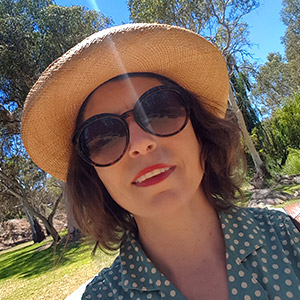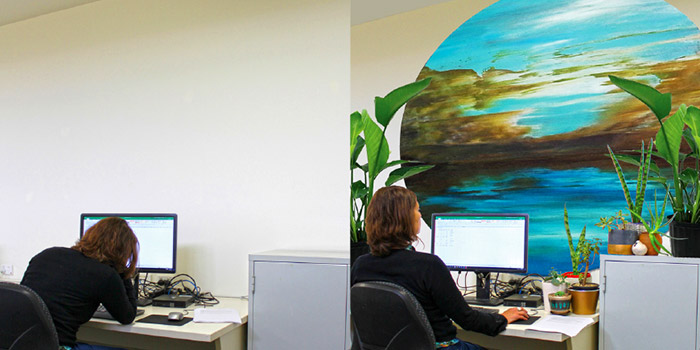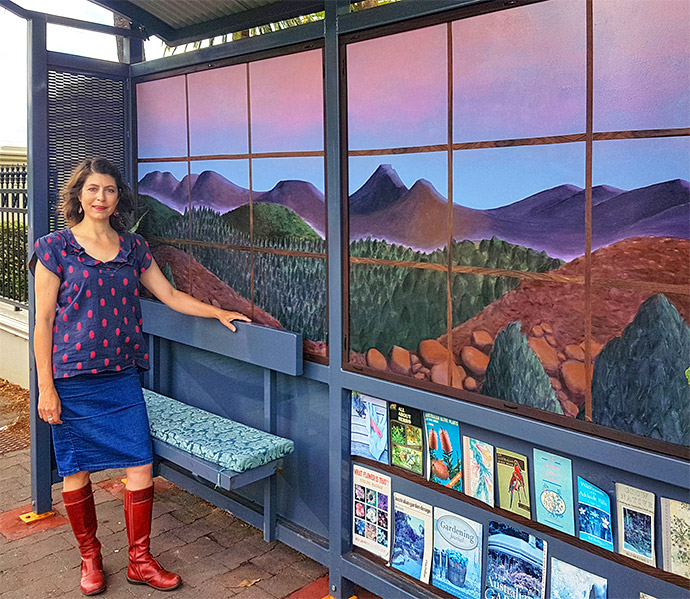 Soothing the work-weary brain in a windowless office
Soothing the work-weary brain in a windowless office
SAMHC Featured Blogger:
Bridgette Minuzzo
Visual Artist and PhD candidate, University of South Australia
The increasing disconnect of people in cities from the natural environment may be contributing to stress and mental health issues.
Decades of research from environmental psychology, landscape design and health design show the importance of experiencing nature.
Nature-connection reduces stress, pain, mental fatigue, and improves wellbeing, however, over 70 per cent of Australians live in cities, and city people are indoors for around 83 per cent of the day.
Office workers and students work long hours in rooms which frequently lack windows; interior spaces which don’t allow a view to nature, to hills, sky or foliage.
As a PhD candidate, I found myself working in a windowless office where even the plants I introduced struggled with the lack of natural light.
As a visual artist, I know the calming and re-energising effects of engaging with art. This inspired an investigation into the restorative effects on mental fatigue and stress of representations of nature, specifically semi-abstract landscape artwork.
There are many ways to improve cognitive function over the course of a day; optimizing sleep, being organized, and reducing distractions.
Yet no matter how well these strategies are applied, during prolonged hours of working or studying, people experience mental fatigue. The task-focused attention we use when working tires within 25 to 55 minutes.
Nature-connection, even a window view, has been shown to reduce this fatigue and helps us to focus attention, however, many city people don’t have the option of an office with a scenic view.

Into these windowless rooms, I introduced paintings of South Australian landscapes to determine if artworks could make spaces more conducive for work focus.
Landscape paintings were installed at three university campuses and a hospital. I surveyed the effects on participants over a month. The studies generated some interesting findings including that mental fatigue is widespread.
Over 68 per cent of students studied woke feeling tired and 90 per cent of the office workers were mentally fatigued for one to three hours a day.
Yet a simple intervention of viewing the artwork for one to five minutes made a significant difference. Participants in all three studies recorded a 20 to 40 per cent reduction in stress and mental fatigue.
Participants reported that the landscape paintings evoked fond memories of holidays and time spent in nature. People recounted taking a moment, a minute, to look at the landscape painting and calm their mind.
Essentially, a series of micro-breaks ameliorated mental fatigue and work pressures until there was time for a longer break. These ‘art breaks’ offered a sense of nature-connection, a chance to be mentally out in nature, which produced a calming and relaxing effect.
In addition, I found that the semi-abstract paintings inspired visual interpretation. The majority of participants formed three or more associations from one painting (some generated four times as many) demonstrating that the semi-abstract art stimulated imaginative and creative thinking.
My findings question the persistence of clean-wall policies in workplaces and show the benefits of curating nature-themed art in urban workplace design, study areas and public places.

Nature-themed art in the office can help people to rest and refocus, at their desk, as the need arises. Art in the office is not a distraction or decorative extra; it can improve mental wellbeing and productivity.
Offices without views can be more conducive to mental wellbeing by adapting nature-connection principles and curatorial practices from health environments (e.g. the Flinders Medical Centre, Royal Adelaide, Perth Children’s, Fiona Stanley Hospitals).
The knowledge of how to curate nature-themed art into existing interiors, to better manage mental fatigue and stress, is a positive addition to current Government, University and Hospital wellbeing initiatives.
Viewing art has a benefit beyond cultural and aesthetic values; looking at nature-themed art is good for our work-weary brains.
By Bridgette Minuzzo
Visual Artist and PhD candidate, University of South Australia
Bridgette Minuzzo is an Adelaide-based visual artist with over 20 years’ experience in project-based art practice, public art, community art, commissions and exhibition work. She utilizes a diversity of media including photography, video, metal design and painting.
Bridgette’s recent commissions include ‘Phantasmagoria’, Adelaide Festival Centre digital media screens, 2017–2018; bus shelter artworks for the City of Charles Sturt and City of Prospect, 2018 to 2019, and ‘Of Light and Clouds’ an Art Gallery of SA moving image commission in conjunction with Turner from the Tate, 2013.
Bridgette has received awards for exhibition work (City of Adelaide Award 2012), art in public parks (Design institute of Australia, 2004), photography (SALA 2014), community art (2014 Education and Arts Minister’s Award, Artist-in-Schools) and for performing a play about her PhD (National Science Week, 2018).
Her PhD investigates the potential of landscape art to evoke nature-connection, and thus improve mental wellbeing for people working in windowless spaces. The PhD is currently under examination.
An exhibition of Bridgette’s landscape paintings is at the Sir Ivor Hele Gallery, Royal Adelaide Hospital, until July 29.
SAMHC Featured Bloggers
The SAMHC presents our series of guest featured bloggers who generously share their personal thoughts and experiences of mental health and wellbeing.


